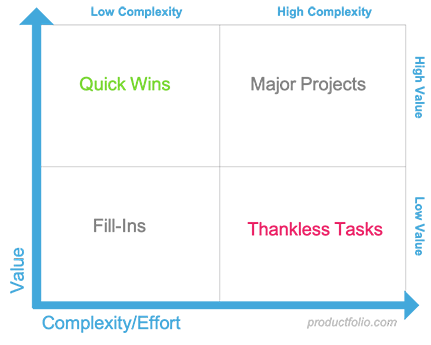Value vs Complexity Prioritization Matrix
In simple terms, value vs. complexity is a framework that enables you to prioritize initiatives by considering their inherent value and complexity of execution. It is a tool that you use for evaluating ideas in light of their value to users and your business relative to how complex they are to implement.
This model is one of many that product managers regularly use to prioritize product roadmap initiatives. It offers a standard approach to decision-making. You will find it useful for being more strategic about what initiatives to give attention to, especially when you have limited time or resources.

How to Prioritize with the Value vs. Complexity
Value vs. complexity is a matrix featuring four quadrants, which form categories into which you place initiatives. The idea is to identify low-hanging fruits you can start with. Let’s take a look at how you prioritize with this framework.
Assign value scores
With your list of initiatives ready, work out a value score for each one.
Several factors may come into consideration when determining a score. You could consider value from more than one perspective – at least, from yours and that of your users. For example, how will an initiative benefit your business? How does it address your target audience’s pain points? How many of the target users will the initiative affect?
Score each of the factors that influence value. Then add everything together to get a single overall score. You may opt to weigh some subcategories higher than others.
Decide complexity scores
Next, determine how difficult your initiatives will be to execute by giving them scores as well. Some product teams simply capture complexity as costs. The model becomes practically the same as the Value vs. Cost framework in this case.
Other factors may also be considered in arriving at a complexity score. Among these are time or development hours, risks, expertise constraints, and necessary customer support or training. These can form subcategories that influence the overall score for an initiative.
Plot your initiatives
Use the value and complexity scores you have worked out to plot each initiative in a graph. The matrix should be divided into four boxes. With “Value” on the Y-axis and “Complexity” on X, this gives you the following categories of initiatives:
High value, low complexity (top-left) – Here, you have the initiatives that should receive the highest priority.
High value, high complexity (top-right) – These initiatives may be considered next after those in the first category if their high complexity isn’t overwhelming.
Low value, low complexity (bottom-left) – These initiatives don’t offer much value but are worth considering since they’re easy to execute and may improve customer satisfaction.
Low value, high complexity (bottom-right) – You may be better off dropping the initiatives here.
Building Great Products with Value vs. Complexity
This framework is well-suited for when you are trying to build a new product. It may be somewhat hard to justify its usefulness for matured offerings. The value vs. complexity matrix helps you to identify those initiatives that are likely to have the most impact. It lets you discover those “low hanging fruit” initiatives that deliver high value with minimal efforts. This also means that you will find the model perfect when you’re looking to achieve the most with limited resources.